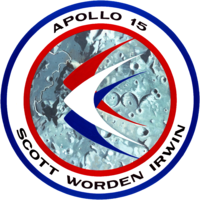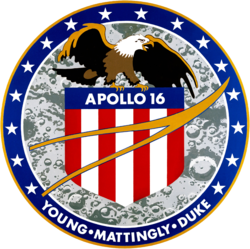Apollo 15
| Apollo 15 | |||
 | |||
| Statistik för uppdraget | |||
|---|---|---|---|
| Uppdrag | Apollo 15 | ||
| NSSDC-ID | Kommandomodul: 1971-063A[1] Månlandare: 1971-063C[2] | ||
| Kommandomodul | Endeavour | ||
| Månlandare | Falcon | ||
| Anrop | Endeavour ("strävan") Kommandomodul Falcon Månlandare | ||
| Uppskjutning | |||
| Raket | Saturn V | ||
| Uppskjutningsramp | John F. Kennedy Space Center LC-39A | ||
| Uppskjutning | 26 juli 1971 13:34:00 UTC | ||
| Landning | |||
| Landning | 7 augusti 1971 20:45:53 UTC | ||
| Månen | |||
| Antal varv kring månen | 74 st | ||
| Månlandning | 30 juli 1971 22:16:29 UTC | ||
| Månuppskjutning | 2 augusti 1971 17:11:23 UTC | ||
| Månprover, vikt | 77 kg | ||
| Antal månpromenader | 4 st | ||
| Månpromenader, längd | 19 timmar, 7 minuter, 53 sekunder | ||
| Dockning | |||
| Dockning | 26 juli 1971 17:07:49 UTC | ||
| Ur dockning | 30 juli 1971 18:13:16 UTC | ||
| Andra dockningen | 2 augusti 1971 19:10:25 UTC | ||
| Andra ur dockning | 3 augusti 1971 01:04:01 UTC | ||
| Rymdpromenad | |||
| Antal rymdpromenader | 1 st | ||
| Total tid för rymdpromenad | 39 minuter, 7 sekunder | ||
| Besättning | |||
| Befälhavare | David Scott | ||
| Pilot | Alfred Worden (kommandomodulen) James B. Irwin (månlandaren) | ||
 | |||
| Kronologi | |||
| |||


Apollo 15 var den nionde bemannade rymdfärden i Apolloprogrammet och den fjärde gången som människan landade på månen.
Den sköts upp från John F. Kennedy Space Center den 26 juli 1971 och den 30 juli landade två av de tre besättningsmännen på månytan, norr om berget Mons Hadley Delta i bergskedjan Montes Apenninus.
Befälhavare David Scott och månlandarens pilot James B. Irwin stannade sammanlagt 3 dagar på månen, därav 18 och en halv timme utanför modulen. Med hjälp av ett fordon, månbilen, kunde de också ta sig längre bort från månlandaren än som hade varit möjligt tidigare. Sammanlagt samlade de ihop 77 kilo sten och sand. På den andra turen hittades vid foten av Mons Hadley den så kallade Genesis Rock, en sten som har uppskattats vara 4 miljarder år gammal.
Medan Scott och Irwin befann sig på månens yta stannade Alfred Worden kvar i kommandomodulen Endeavor och använde diverse instrument, bland annat en spektrometer, för att ta reda på mer om månen.
Till skillnad från tidigare uppdrag lades större vikt vid vetenskaplig forskning än som hade varit fallet tidigare. Då hade man varit tvungen att koncentrera sig på att få färden till månen, månlandningen och återresan att fungera tekniskt. De tre återvände till jorden den 7 augusti.
Besättning
- David Scott, befälhavare
- James B. Irwin, månlandarpilot
- Alfred Worden, kommandomodulpilot
Väckningar
Under Geminiprogrammet började NASA spela musik för besättningar och sedan Apollo 15 har man varje "morgon" väckt besättningen med ett särskilt musikstycke, särskilt utvalt antingen för en enskild astronaut eller för de förhållanden som råder.
Media
- Video från uppskjutningen den 26 juli
- Video som visar månlandningen 30 juli
- Video från en utflykt med månbilen 1 augusti
Se även
Referenser
- ^ ”NASA Space Science Data Coordinated Archive” (på engelska). NASA. https://nssdc.gsfc.nasa.gov/nmc/spacecraft/display.action?id=1971-063A. Läst 27 mars 2020.
- ^ ”NASA Space Science Data Coordinated Archive” (på engelska). NASA. https://nssdc.gsfc.nasa.gov/nmc/spacecraft/display.action?id=1971-063C. Läst 27 mars 2020.
Externa länkar
 Wikimedia Commons har media som rör Apollo 15.
Wikimedia Commons har media som rör Apollo 15.
| |||||||||||||||||||||||||||||||||||||||||||
| |||||||||||||||||||||||||||||||||
Media som används på denna webbplats
Författare/Upphovsman: Pascal (Flickr user: pasukaru76), Licens: CC0
Vostok spacecraft replica at the Technik Museum Speyer, Germany.
Image from Apollo 15, taken by Commander David Scott at the end of EVA-1. Lunar Module Pilot Jim Irwin is seen with the Lunar Roving Vehicle, with Mount Hadley in the background. Seen on the back of the Rover are two SCBs mounted on the gate, along with the rake, both pairs of tongs, the extension handle with scoop probably attached, and the penetrometer. Note that the TV camera is pointed down, in the stowed position.
Logo of Apollo 15
This is the insignia designed for the Apollo 15 lunar landing mission. The circular design features the colors red, white and blue. On the outer portion of the patch a narrow band of blue and a narrow band of red encircle a wider band of white. The large disc in the center of the emblem has red, white and blue symbols of flight, superimposed over an artist's concept of the Apollo 15 Hadley-Apennine landing site of gray tone. The surnames of the three names are centered in the white band at the bottom of the insignia. The Apollo 15 prime crew men are David R. Scott, commander; Alfred M. Worden, command module pilot; and James B. Irwin, lunar module pilot.
16mm film sequence during a drive on the Lunar Rover. It is likely from EVA2 "Apollo 15 experienced problems with the 16mm sequence camera on the lunar surface. At the crew debriefing, Jim Irwin said "Of all the ones [film magazines] we tried on the surface only one drove...""
Launch of Apollo 15.
One of a series of images taken as a pan of the Apollo 15 landing site, taken by Commander Dave Scott. Featured is the Lunar Roving Vehicle at it's final resting place after EVA-3. At the back is a rake used during the mission. Also note the red Bible atop the hand controller in the middle of the vehicle, placed there by Scott.
16 mm film shot from the Lunar Module Pilot's window during the landing of Apollo 15 at Hadley Rille. Starts at about 5000 feet above the surface.
Apollo 16 mission logo
The Apollo 16 crew patch is dominated by an eagle perched atop a red, white and blue shield a superimposed on a lunar scene, surrounded by a blue circle of 16 stars with the crew's surnames completing the bottom are of the circle. Across the face of the shield is a gold symbol of flight outlined in blue, similar to that on the National Aeronautics and Space Administration (NASA) agency seal and insignia. The design was created by NASA artist Barbara A Matelski[1][2] from ideas submitted by the three crew members: astronauts John W. Young, commander; Thomas K. Mattingly II, command module pilot; and Charles M. Duke Jr., lunar module pilot.
This is the Apollo 14 crew patch designed by astronauts Alan B. Shepard Jr., commander; Stuart A. Roosa, command module pilot; and Edgar D. Mitchell, lunar module pilot. It features the astronaut lapel pin approaching the Moon and leaving a comet trail from the liftoff point on Earth. The pin design was adopted by the astronaut corps several years ago. Astronauts who have not yet flown in space wear silver pins. Those who have flown wear gold pins.














